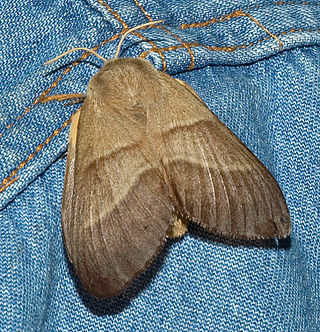
The Arctiinae are a large and diverse subfamily of moths with around 11,000 species found all over the world, including 6,000 neotropical species. This subfamily includes the groups commonly known as tiger moths, which usually have bright colours, footmen, which are usually much drabber, lichen moths, and wasp moths. Many species have "hairy" caterpillars that are popularly known as woolly bears or woolly worms. The scientific name Arctiinae refers to this hairiness. Some species within the Arctiinae have the word "tussock"' in their common names because they have been misidentified as members of the Lymantriinae subfamily based on the characteristics of the larvae.

Bombycoidea is a superfamily of moths, including the silk moths, giant silk moths, sphinx moths, saturniids, and relatives. The superfamily Lasiocampoidea is a close relative and was historically sometimes merged in this group. After many years of debate and shifting taxonomies, the most recent classifications treat the superfamily as containing 10 constituent families.

Petaloudes is a former municipality on the island of Rhodes, in the Dodecanese, Greece. Since the 2011 local government reform it is part of the municipality Rhodes, of which it is a municipal unit. Its population was 15,086 in 2021. It includes the villages of Kremasti, Paradisi, Theologos (Tholos), Damatria, Maritsa, and Pastida. The seat of the municipality was in Kremasti. The land area is 89.150 km2.

The Bombycidae are a family of moths known as silkworm moths. The best-known species is Bombyx mori (Linnaeus), or domestic silk moth, native to northern China and domesticated for millennia. Another well-known species is Bombyx mandarina, also native to Asia.

The Pyralinae are the typical subfamily of snout moths and occur essentially worldwide, in some cases aided by involuntary introduction by humans. They are rather rare in the Americas however, and their diversity in the Australian region is also limited. Altogether, this subfamily includes about 900 described species, but new ones continue to be discovered. Like many of their relatives in the superfamily Pyraloidea, the caterpillar larvae of many Pyralinae – and in some cases even the adults – have evolved the ability to use unusual foods for nutrition; a few of these can become harmful to humans as pests of stored goods.

The Lasiocampinae are a subfamily of the moth family Lasiocampidae. The subfamily was described by Thaddeus William Harris in 1841.

The Callimorphina are a subtribe of woolly bear moths in the family Erebidae. The subtribe was described by Francis Walker in 1865. Many of these moths are easily confused with butterflies, being quite brightly colored and somewhat diurnal. Their antennae are not thickened into "clubs", which is a typical characteristic of butterflies.

Euplagia is a genus of tiger moths in the family Erebidae. The genus was erected by Jacob Hübner in 1820.
Spanish flag is the national flag of Spain.

Euplagia quadripunctaria, the Jersey tiger, or Spanish flag, is a diurnal moth of the family Erebidae. The species was first described by Nikolaus Poda von Neuhaus in 1761. The adult wingspan is 52–65 millimetres (2.0–2.6 in), and they fly from July to September, depending on the location. They tend to fly close to Eupatorium cannabinum.
Beralade is a genus of moths in the family Lasiocampidae first described by Francis Walker in 1855.
Mallocampa is a genus of moths in the family Lasiocampidae. The genus was erected by Per Olof Christopher Aurivillius in 1902.
Pseudolyra is a genus of moths in the family Lasiocampidae. The genus was erected by Per Olof Christopher Aurivillius in 1925.

Cerace is a genus of moths belonging to the subfamily Tortricinae of the family Tortricidae.

Epipyrops is a genus of moths in the family Epipyropidae. Also known as Fulgoraecia.
Epipyrops fuliginosa is a moth in the family Epipyropidae. It was described by Willie Horace Thomas Tams in 1922. It is found in India.

Thaumetopoea is a genus of moths belonging to the family Notodontidae. It was first described by Jacob Hübner in 1820.
Sena is a genus of moths belonging to the family Lasiocampidae.












